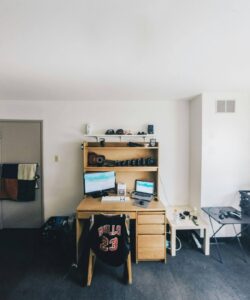 With every new admissions cycle, colleges continue to receive record breaking numbers of applications. This is no surprise, as the need for a college education becomes essential in landing a job in the current market. But with this growing demand, colleges and universities are accepting more students than they have room for, putting a new kind of strain on already stressed freshmans and the housing market in surrounding areas. Students are finding it difficult to find stable housing within and outside university grounds due to demand and exorbitant prices.
With every new admissions cycle, colleges continue to receive record breaking numbers of applications. This is no surprise, as the need for a college education becomes essential in landing a job in the current market. But with this growing demand, colleges and universities are accepting more students than they have room for, putting a new kind of strain on already stressed freshmans and the housing market in surrounding areas. Students are finding it difficult to find stable housing within and outside university grounds due to demand and exorbitant prices.
Why is there a student housing crisis?
There are several factors that have contributed to the growing student housing crisis. The pandemic itself is a culprit, where many students who were college-bound decided to delay their entry to university or take a year or two off due to the potential health risks, closures, and overall instability that COVID-19 provoked.[1] Now, most of them are returning to campus, making existing classes of abnormal quantity even more crowded. In the current market, it is nearly impossible to get a job without a college education, so more and more students are deciding to get a degree. Colleges have also continued to accept more students than they can house—something that they have always done because a percentage of those accepted are likely to defer, go to a different university, or decide not to go altogether.[2] However, that isn’t happening as frequently as previous years.
Another issue is the rise in inflation over the past couple of years—making already high tuition prices and rents higher. Students are unable to afford on-campus housing, which more often than not costs more than tuition.[3] And when they turn to off-campus housing, they face a similar problem: landlords jack up prices, especially in urban areas where demand is high like Boston and surrounding cities of California Universities. There is also an “overabundance of luxury buildings in the development of new housing,” which are simply not viable options for college students.[4] Lastly, there is also a general housing crisis, where there is not enough housing for non-students and students alike.[3] All of these factors come together to form an environment of intense stress, financial strain, competition, and homelessness for students.
How are students dealing with these issues?
Students who know in advance that they are unlikely to get housing resort to delaying their college plans another semester or year. Those who find out too late that their university will not house them are forced to scramble and scour Facebook groups and university forums asking for potential housing options like subletting, or consider shelters in the area. Students often need to find two or more roommates in order to afford rent—regardless of square footage. Open houses are competitive and scarce, and usually it comes down to who can pay everything first, which can be a problem for students dependent on financial aid or simply do not have the resources to pool money together that quickly.[3] Landlords also tend to significantly increase rental costs and purposely prey on desperate college students. A Forbes article notes that, “off-campus rents have gone through the roof—nationally, they’re averaging $2,062 a month, up 28% from $1,614 at the start of 2021.”[3] In cities like Boston, studio apartment rents can start as high as $2,682.[5] Many consider not going to college at all after dealing with the difficulties of finding housing, or choose to stay home and go to nearby colleges, if at all.
While it may seem like an extreme decision, the option of not securing any type of housing but choosing to still pursue a degree, forces some students into homelessness. Students are resorting to living out of their cars, hopping from homeless shelter to shelter, and even living on the street.[1] Homeless rates for college students are almost 1 in 10.[4] Students who are low income, entering college from foster care, are part of underrepresented communities, students of color, or LGBTQ+ students, are all more likely to become homeless. This is for a variety of factors including reliance on federal aid that can be insufficient as well as the lack of an external support system.
Even students who come from affluent backgrounds appear to be struggling, as the housing market no longer seems like a worthwhile investment for their parents due to higher interest rates.[1] In this, students who would typically have no problem finding off-campus housing are now also competing with others who have even more challenges.
Housing insecurity is a pressing issue that affects other areas of student life. It can lead to food insecurity and malnutrition as well as poor sleep, which can all contribute to poor class attendance and overall performance in school. Unhoused students are also more likely to engage in illicit and hurtful activities like using drugs or shoplifting and are less likely to complete their degree.[3] Finding housing while in college isn’t just a matter of having a roof over your head while bettering yourself, but also about ensuring that you have a good future.
How are colleges and universities responding?
Universities have come up with some solutions—though the majority of them are temporary and aren’t realistic long term plans. But they’re trying! An unpopular but effective solution for many colleges has been to convert single occupancy rooms and double occupancy rooms into doubles or triples.[1] Some smaller private colleges, like Middlebury College, are paying students to take a semester off in order to make room for incoming students. Others have resorted to leasing out hotels or apartment buildings for set periods of time to accommodate the growing student population. Virginia State University claims to have assigned a bed to every student that applied for one with the addition of premade modulars.[1] And some colleges are even partnering with neighboring schools to house their overflow of students in underutilized dorms.[6] In a surprising turn, universities have also established new study abroad programs that specifically target first years—who are typically not eligible—so that they do not have to worry about housing.[1]
While some of these may be more affordable for some universities than others and can be long term solutions like apartment buildings—distance from campus centers becomes another issue. Many of these temporary options are miles away from campus, which can make it incredibly difficult for students to commute.[6]
Not many universities seem to be employing any sort of subsidized housing or relying on federal support to meet demands for not just more housing, but more affordable housing.
What else can they do?
Universities can continue to employ some of the options they already have—like continuing to order and build modular buildings. These “temporary” buildings are typically well structured, less expensive than regular construction, faster to develop, and come with all the essential parts of regular buildings like sprinklers.[5] In addition to modular housing, they should also begin to make use of “underutilized land” and build affordable housing.[7] These would likely take years to build, which is why modulars are important. The cost and process of building new dorms may not be immediately tangible for underfunded universities, so working closely with federal agencies to finance expansion is necessary. State governments can also become more involved, much like the governor of California, who recently signed a bill that facilitates the construction of dorm buildings after a court ruling blocked a building project.[3]
These solutions are not quite immediate, so in the meantime, outreach and support should be emphasized. Some universities have established a new position or department that basically functions as a liaison between the college and students to help identify and help students who are at risk of being or already are homeless.[3] With this knowledge, they can then provide additional support, be it in the form of additional grants, referrals to known or reserved housing, priority for future on-campus housing, or even simply make them aware of programs and resources available like food banks and long-term shelters. They can also advocate on behalf of students to local, state, federal governments and NGOs to create more programs for students that need housing assistance.[8]
By implementing these aspects, you address the immediate needs of students while also taking measures to decrease the demand for housing in future enrolling students.
How does PSG fit into this?
Publishing Solutions Group is committed to ensuring that students receive necessary academic support and resources. We meet the needs of our clients, creating products that are valuable for all students. Our forte is content development and subject-matter expertise, but as a company dedicated to educational success, we ensure we are always aware of key and growing matters that impact education across the US.
[1] https://theliteracybrain.com/2019/07/30/the-benefits-of-book-clubs/
[2] https://cpet.tc.columbia.edu/news-press/book-clubs-that-build-21st-century-skills
[3] https://wingsforkids.org/book-clubs-for-sel-skill-building
[4] https://libromaniacs.com/benefits-of-a-book-club/
[5] https://files.eric.ed.gov/fulltext/EJ1171691.pdf
[6] https://wingsforkids.org/book-clubs-for-sel-skill-building
[7] https://libromaniacs.com/benefits-of-a-book-club/
[8] https://files.eric.ed.gov/fulltext/EJ1171691.pdf
Image free to use under the Unsplash license.




